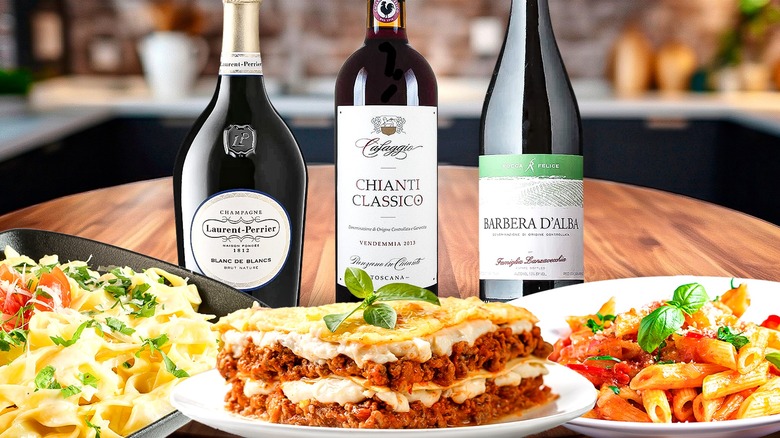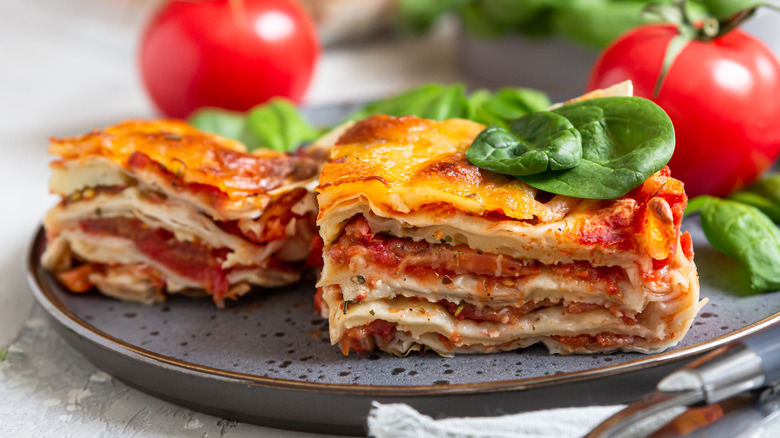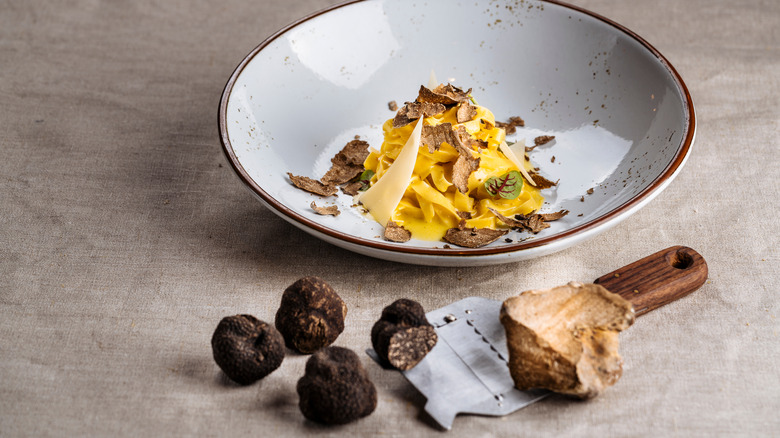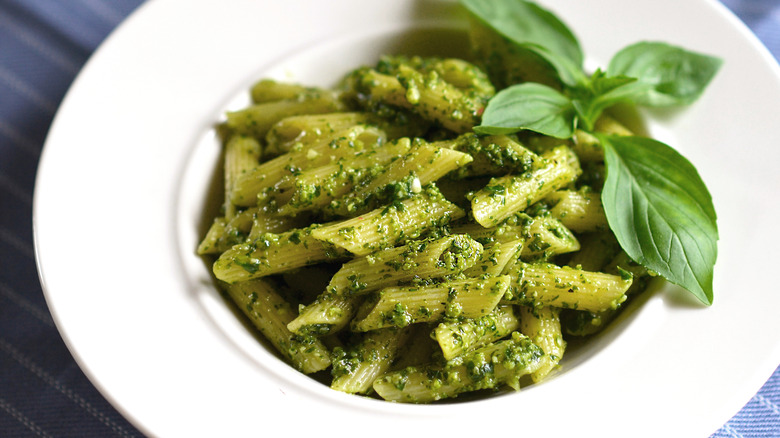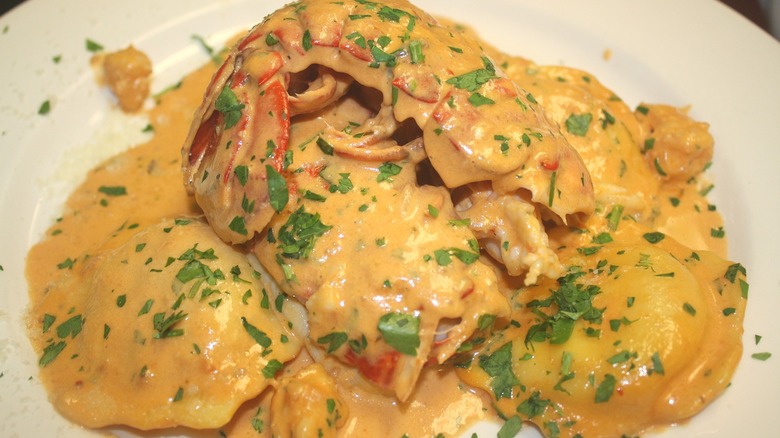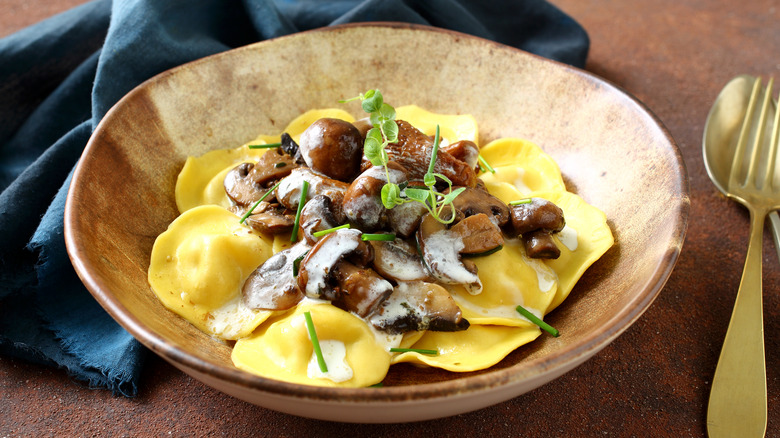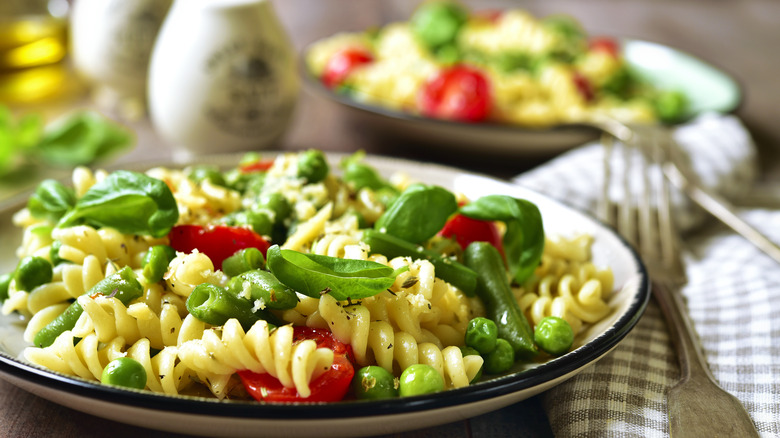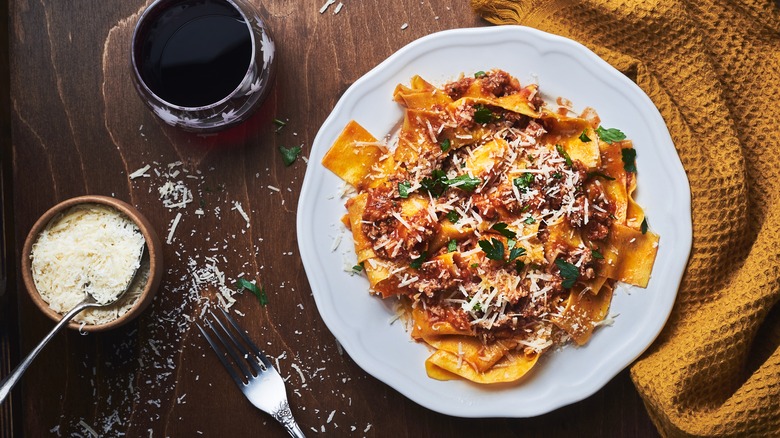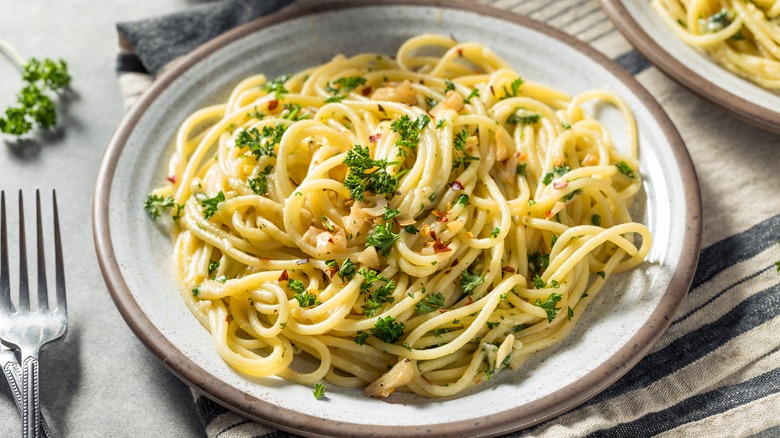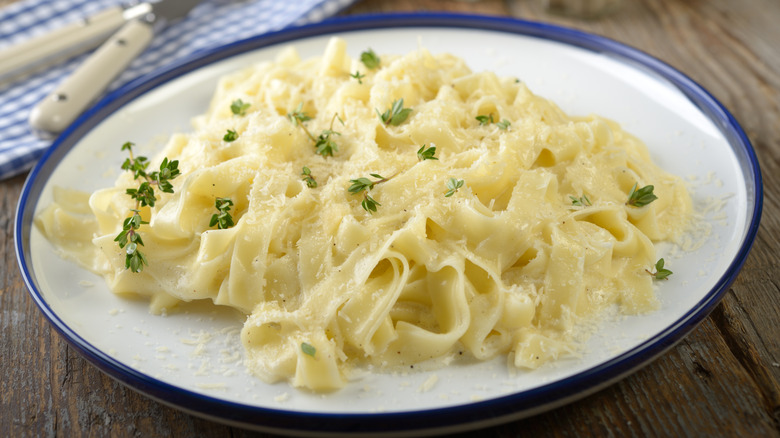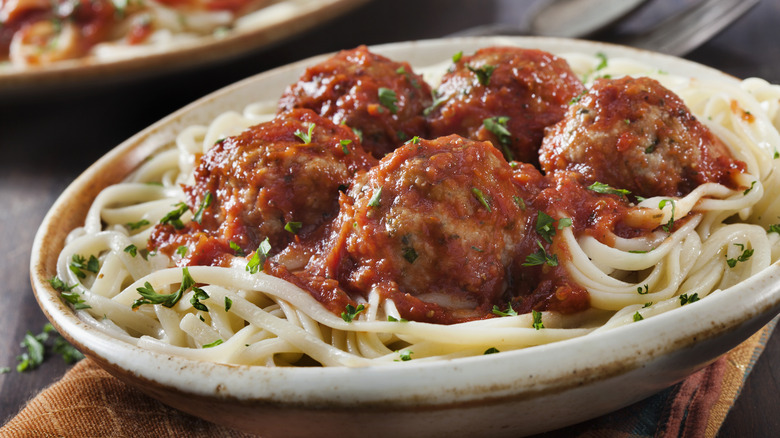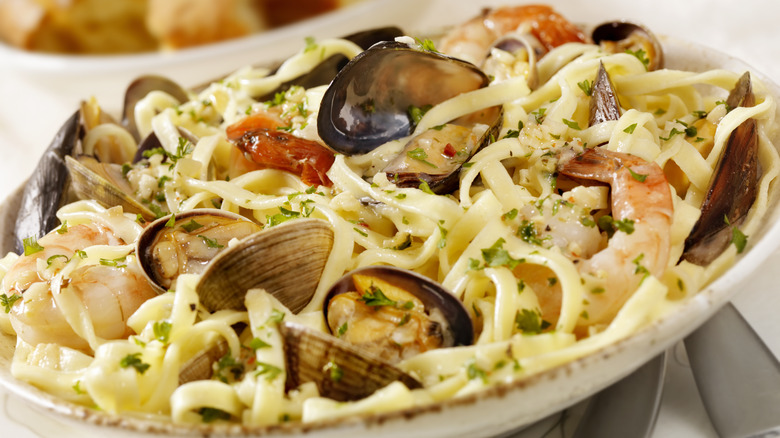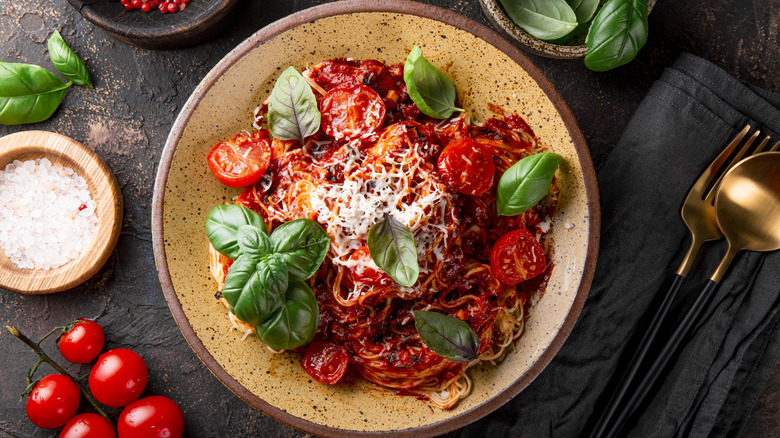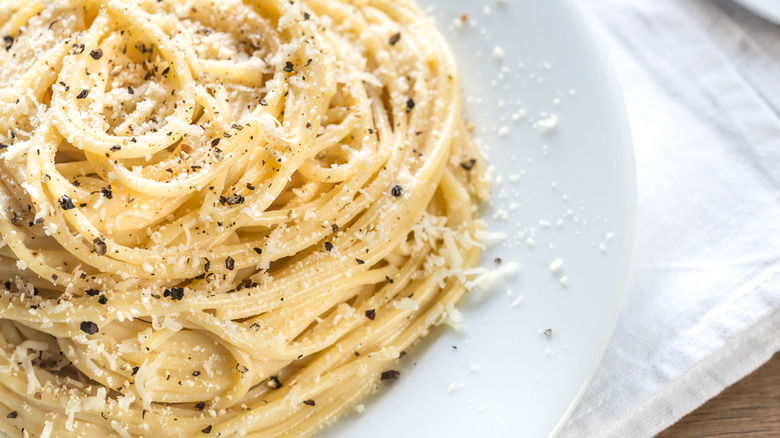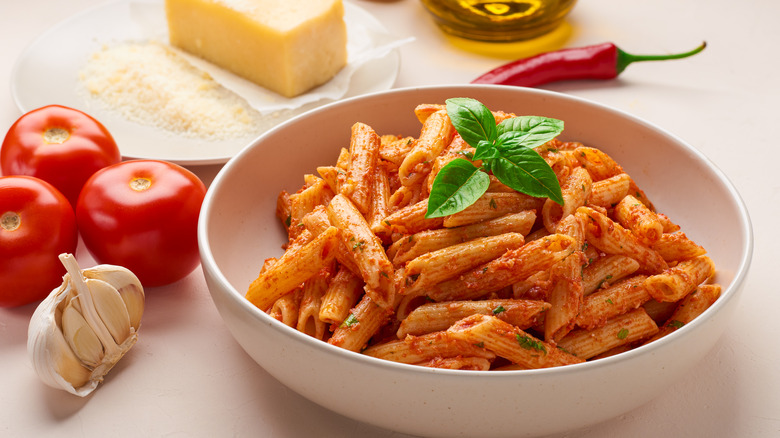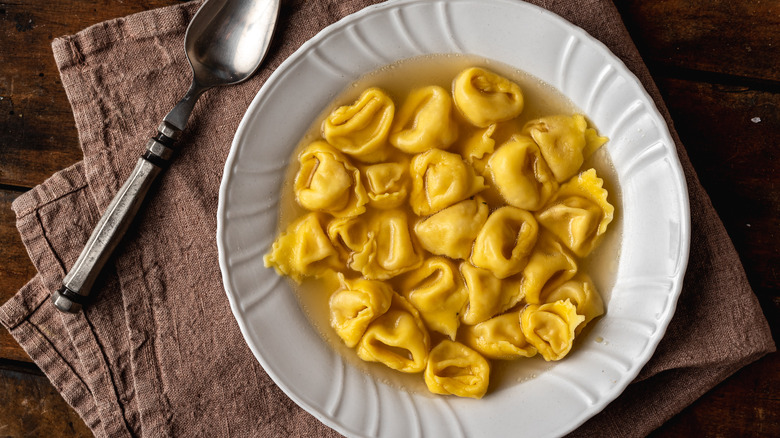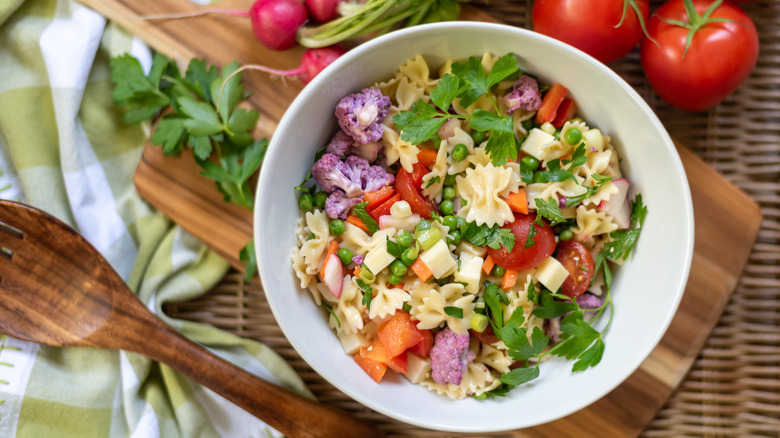The Absolute Best Wines To Pair With Popular Pasta Dishes
Few things are as satisfying as a warm bowl of pasta, ideally paired with a glass of wine. Though the origin of noodles dates back at least 4,000 years in China, pasta is the quintessential dish of Italy. Some 350 pasta varieties exist in Italy, with each region of the Mediterranean country showcasing different shapes, sauces, and styles. The country also crafts wine from about 350 different native grape varieties approved for use by Italian authorities, which represent only a tiny fraction of the number of wine grape varieties growing worldwide.
Deciding on which wine to pair with a pasta dish can be challenging, with so many options to choose from. We suggest keeping a few things in mind, including focusing on the sauce. Though the shape of the pasta is important, as the shape will highlight other ingredients in the dish, the most essential element to consider when pairing wine is the sauce. Pasta sauces can be rich, so wine pairings need to have fresh acidity to help balance the flavor. Other ingredients in the dish should also be considered, like if it includes meat, which will require a wine with more heft and tannin, breaking down the protein's fatty qualities. To help guide you toward the best options, we compiled a list of some of our favorite wines to pair with an assortment of well-known pasta dishes.
Lasagna with Chianti Classico
A classic slice of lasagna is a beautiful sight to behold. Thin pasta sheets layered with rich meaty ragù, chunky marinara sauce, creamy béchamel, and gooey mozzarella create a dream for Italian food lovers. And nothing goes better with lasagna than a glass of Chianti Classico.
Crafted from at least 80% sangiovese grapes, with the remainder often derived from other native Italian grapes like colorino or canaiolo, this dry red wine pairs well with many of Italy's favorite tomato-rich pasta dishes due to its bright acidity, well-balanced tannins, and medium body. Chianti Classico will lift the palate, slicing through the fattiness of the meaty ragù, béchamel, and cheese. The wine is savory, with aromas that layer wild herbs like sagebrush and thyme with ripe berries and sour cherries. Selections from Banfi, Frescobaldi, and Tenuta di Arceno showcase the rustic beauty of this Tuscan-region wine, revealing an authentic sense of place in each bottle.
Truffle pasta with Barolo
The truffle is one of the world's most luxurious foods, with an intense earthy, forest-floor aroma and umami flavor. And the only wine to pair with an ingredient with such a high profile is a regal, robust Barolo wine made from nebbiolo grapes. Considered as one of Italy's most prized red wines, Barolo is derived from the northern Piedmont region — which also happens to be the home of Alba white truffles, cherished as one of the rarest and most expensive truffle varieties. Following the adage that if it grows together, it goes together, Barolo wine and Alba truffles make an ideal combination by highlighting the terroir with balanced bold flavors.
Wines made from nebbiolo fruit are full-bodied, robust, and tannic, with black cherry, berry, and spice characteristics. Similarly, the truffle's full flavor and intense, earthy qualities will complement the wine's nose. We recommend pairing a classic truffle cream pasta topped with thinly shaved white or black truffle served with a Barolo selection from a multi-generational producer like Enrico Serafino or Pio Cesare.
Pesto penne with Sauvignon Blanc
Basil pesto is one of the most versatile condiments to have in your kitchen. We love adding fresh basil pesto to grilled salmon, chicken, or shrimp. Pesto makes the perfect sauce for roasted vegetables, leafy green salads, and, of course, fresh pasta. To cut through the piquant flavor of cheesy, citrusy, herbaceous pesto with pasta, you need a wine with bright acidity and a hint of minerality, like a Sauvignon Blanc. We like the selections from New Zealand — like the wines from Craggy Range or Cloudy Bay — for a penne-with-pesto pairing.
New Zealand's Sauvignon Blanc wines reveal layers of punchy fresh citrus, gooseberry, tropical fruit, and grassy notes, which meld well with the basil pesto's fresh herbaceous qualities. The lean acidity of the dry wine complements the sauce base of basil and olive oil laden with parmesan cheese, pine nuts, pepper, lemon, and garlic, balancing its weight by bringing a zesty note of freshness to your palate.
Lobster ravioli with Chardonnay
Lobster ravioli is one of our favorite luxurious pasta dishes, preferably with a butter-poached lobster tail on top. The succulent combination of lobster and ricotta cheese stuffed into a pillowy ravioli slathered in a sauce of white wine, heavy cream, and butter makes our hearts flutter and mouths water. The wine pairing must not overpower the decadence of the pasta. It should enhance the natural sweetness of the shellfish and complement the silky flavors while balancing the sauce's creaminess.
We recommend a Chardonnay to pair with the dish, like a steely option from the French region of Chablis, or a slightly fruitier selection from California's SLO Coast, like Tolosa 1772 Chardonnay. Both options provide lovely citrus, orchard fruit, and melon notes with aromas of lemon blossom and honeysuckle. A selection from Chablis will be leaner, with more mineral, crushed-stone characteristics, and vigorous acidity due to the regional terroir. Tolosa's Chardonnay will have more fruit-forward flavors while providing similarly refreshing acidity thanks to the region's cool-climate growing conditions.
Mushroom ravioli with pinot noir
Few foods take on the characteristics of a terroir as well as mushrooms. The earthy fungi is a reflection of the place it has grown. Mushrooms and pinot noir wine are a classic pairing. The medium-bodied, dry red wine shows earthy flavors of dried leaves, forest floor, and truffle, complementing the naturally earthy umami in mushrooms. These savory notes meld with layers of ripe berries, pomegranate, and cherries. Pinot noir is generally grown in regions that enjoy a cool climate, like Burgundy, northwestern Italy, western Germany, and the U.S. Pacific coast. The cool climate of these regions ensures pinot noir wines retain acidity throughout the growing season, which provides the finished wine with luscious freshness.
To pair with mushroom ravioli (which can be stuffed with porcini, portabella, or other hearty mushrooms), we suggest choosing European pinot noir or a selection that reflects a similar Old World style, like a pinot noir from Willamette Valley. Arguably one of the finest areas to grow the grape in the New World, Willamette Valley pinot noir selections from Adelsheim, Nicolas Jay, and Résonance display gorgeous red fruit flavors along with earthy, savory qualities of truffle, leather, fennel, and violets. The wines have a freshness and medium, balanced tannins, accentuating the umami qualities of the ravioli.
Pasta primavera with vermentino
Vermentino wines are like sunshine in a glass. The white wine's production is from throughout the western Mediterranean, including various parts of northwestern Italy, Sardinia, Corsica, and southern France, where it is known as rolle. The grapes grown in Sardinia enjoy considerable influence from the sea, bringing a note of briny salinity to the lemon-lime, white pepper, and tart apple flavors.
Surrau's Branu Vermentino di Gallura is from Sardinia's Arzachena region. Here, sustainably grown grapes thrive in well-draining sandy and granite soils, which lend a crisp, mineral note to this wine's acidity. The term branu is said to derive from the Spanish word verano, or summer, making this wine the perfect accompaniment to a lighter warm-weather dish like roasted vegetable pasta primavera.
This pasta dish combines seasonal fresh vegetables — like red peppers, grape tomatoes, and asparagus — with cream, parmesan cheese, and a heaping handful of fresh basil. The type of pasta is your choice. Thirst-quenching, tart, and juicy, vermentino offers crisp acidity that will cleanse the palate from the creamy pasta sauce while lifting the natural flavors of the vegetables.
Bolognese with Valpolicella Superiore
Bolognese is the hearty, meaty ragù of Bologna, Italy. The slow-cooked sauce often combines ground beef and pork with tomatoes, carrot, celery, onion, wine, stock, herbs, and time. It is essential to allow the sauce enough time to cook to incorporate and meld all ingredients slowly when preparing a proper Bolognese. The patient cooking process ensures the sauce will be thick, rich, and comforting.
To pair with the heavy sauce, we love a Valopicella Superiore from Veneto, Italy. Zenato Ripassa Valpolicella Superiore is a blend of corvina, rondinella, and oseleta grapes. When producing the wine, a portion of the juice goes through a second fermentation using the spent Amarone lees, or yeasts, from Amarone fermentation. This secondary fermentation adds texture, body, and flavors, producing a well-rounded red wine with bold character. Ripe blue and black fruit flavors meld with savory spice, woody herbs, chewy tannins, and fresh acidity, creating balance with the meaty dish.
Spaghetti aglio e olio with pinot grigio
The combination of olive oil, garlic, and crushed red pepper makes aglio e olio as simple as Neapolitan pasta can get, while packing a punch of flavor. Its origin is considered Naples, where Italians employ a simplistic, no-waste approach to cooking, using a few high-quality ingredients to create dishes with authentic rusticity. Today, versions of aglio e olio are enjoyed throughout Italy, with regional variations that include additional ingredients like cherry tomatoes, anchovies, capers, or toasted breadcrumbs. The critical element for all spaghetti aglio e olio is high-quality olive oil with herbaceous, peppery freshness. The wine pairing for this garlicky, spicy, mouth-coating sauce must be fresh, bright, and fruit-forward, like a lemony pinot grigio.
We suggest the options from Italy's Alto Adige region. The high-elevation vineyards there create vibrant pinot grigio wines with juicy, fruity flavors balanced with higher acidity levels. Alois Lageder Porer Pinot Grigio shows layers of peach, melon, and spice with a lively, dry palate. The fruitiness of the wine brings out the fruity qualities of the olive oil while taming the spicy heat from the red pepper flakes.
Fettuccine alfredo with blanc de blancs Champagne
Few pasta dishes are as comforting as a bowl of buttery fettuccine alfredo. It is one of those dishes that warms you from the inside out. The alfredo sauce combines cream, butter, and parmesan cheese to create a mouth-coating sauce filled with succulent fat and flavor. When pairing, you need a wine with brightness and acidity to balance that luscious sauce. We recommend a classic fettuccine alfredo with blanc de blancs Champagne, like Laurent-Perrier Blanc de Blancs Brut Nature Champagne.
This French sparkling wine is made with 100% chardonnay grown in chalky soils, lending layers of citrus and crushed stone. The wine's traditional production method includes a second fermentation in the bottle, which creates the bubbles. With a natural fruit-filled character, this Champagne is finished without using added sugar, allowing the essence of the prestigious region to shine. The lengthy aging process of eight years in the bottle fosters layers of minerality and a lemony finish, harmonizing with the pasta's rich flavors.
Spaghetti and meatballs with Rosso di Montalcino
Produced in a style similar to Chianti Classico, Tuscany's approachable Rosso di Montalcino matches well with a bowl of spaghetti and meatballs. This 100% sangiovese wine is from central south Tuscany, which is also the home of Brunello di Montalcino. Considered as the youthful sibling to the bold, brawny, full-bodied Brunello di Montalcino wines, Rosso di Montalcino has a lighter, fresher style while delivering a full-flavored, dry red wine.
Casanova di Neri's Giovanni Neri Rosso di Montalcino opens with layers of dark fruits like blackberry, black cherry, and plum. The wine is aged 13 months in oak barrels, lending toasted cedar and spice notes. Though the wine is full-bodied and has a high alcohol content of 15%, there is an approachable freshness to the fruit and a soft, velvety texture to the tannins, ensuring that it is ready to enjoy shortly after the wine is released — especially with roasted meats like meatballs or sausages.
Seafood pasta with albariño
Albariño wine bears flavors of the sea, making it the ideal pairing with seafood or shellfish. The white wine's most notable home is the Rias Baixas region in Galicia, Spain, beside the Atlantic Ocean. Here, cool sea breezes blow through pergola-trellised vineyards daily, creating a long growing season that allows the fruit to ripen slowly. The grapes hold acidity while producing juicy, full-flavored fruit. The dry wines are bright, crisp, and clean with a subtle bitterness.
Producers like Fillaboa, Pazos de Lusco, or Terras Gauda create albariño wines filled with nectarine, honeysuckle, stone fruit, and anise. The wines also show a mineral-rich briny salinity from the influence of the Atlantic and the region's clay, silt, and granite-filled soils. This brininess enhances the natural salty seawater flavors of mussels, clams, oysters, and other shellfish. The natural citrus flavors in the wine bring zesty flair to the palate, enhancing the overall pairing similarly to how a squeeze of lemon will lift the flavor of a piece of fish.
Pasta al pomodoro with barbera
Pasta with a pomodoro sauce is an uncomplicated-yet-classic combination. The pomodoro, or tomato pasta sauce, typically includes crushed tomatoes that are slow-cooked with olive oil, garlic, and onion until the sauce becomes thick, velvety, and smooth. There are significant differences between pomodoro sauce and marinara sauce, although some base ingredients are the same. Marinara sauce is chunky and typically includes flavorful additions, like dried herbs such as basil and oregano. On the other hand, pomodoro shows an authentic, sweet, fresh, tomato-forward flavor with a rich sauce that coats pasta noodles. The wine pairing for pomodoro pasta must complement the natural acidity within the tomatoes, like a barbera.
This Piedmontese red wine from northern Italy is an easy-drinking selection with blackberry, cherry, and earthy forest-floor flavors, with low tannin levels and punchy acidity that defines its signature freshness. The wine's acidity will match that of the sauce. A less acidic wine will fall flat on the palate, leaving you wanting more from the pairing. Barbera wines are also affordable, with quality selections available for under $20. They are best shortly after they are released from the winery at the height of their freshness, making a barbera an effortless weeknight wine pairing.
Cacio e pepe with Frascati Superiore
Cacio e pepe is an indulgent pasta dish dating back to the Roman Empire. The pasta is a marriage of pecorino Romano cheese, lots of crushed black pepper, and pasta, including incorporating some of the starchy pasta water into the sauce to thicken it. The pasta shape is typically long, like spaghetti or bucatini.
Bucatini cacio e pepe is rich, creamy, and spicy, requiring a light, fresh, acidic wine to cut through the spice and the richness. Following the same premise of pairing regional dishes with local wines, combining a peppery, cheesy bowl of cacio e pepe with a crisp, clean, dry Frascati Superiore makes the perfect pairing. The dry white wine from the Lazio region just outside of Rome contains a minimum of 70% Malvasia Bianca di Candia or Malvasia del Lazio, with each being a local variety that lends layers of aromatic floral and stone fruit notes to the wine.
The production of traditional Frascati has tended to focus on higher production versus higher quality. However, Frascati Superiore's production takes a different approach, concentrating on quality and authenticity. The wines deliver layers of golden stone fruit, like peach and apricot, with a dry, balanced palate, lifting the buttery qualities of the ancient pasta dish.
Penne arrabbiata with verdicchio
Penne arrabbiata combines tomato, garlic, basil, and olive oil, while the simple ingredient that gives arrabbiata sauce its iconic spice is red pepper flakes. Without the heat, you have marinara. Pairings for spicy foods must balance the heat while complementing the overall flavor. It is best to avoid highly tannic, robust wines that will clash with spicy flavors, making the sauce taste even more intense. Instead, pair penne arrabbiata with a wine that is lighter in body and with crisp acidity, like a verdicchio.
This Italian white wine has been cultivated for more than six centuries, primarily in central Italy's Marche region. The wine's characteristics include layers of citrus flavors of lemon and grapefruit with hints of peach, green apple, and almonds. The fruity character of the wine will meld with the qualities of the simmered tomatoes in the sauce. At the same time, its natural acidity will balance the spicy, peppery flavors. Bright, juicy, and refreshing, this white wine is best served well chilled.
Tortellini en brodo with Lambrusco
One of the classic dishes of Italy's Emilia-Romagna region is tortellini en brodo. Tortellini stuffed with pork in a rich broth and topped with Parmigiano-Reggiano is a heartwarming meal for cold winter nights. Though the dish will pair nicely with a well-rounded dry white wine, we suggest staying regional with a Lambrusco. This sparkling dry Italian wine is crisp and lively, with fresh effervescence. The wine has a fresh acidity that cuts through the richness of slow-cooked bone broth, lifting the flavor and balancing the dish.
Cleto Chiarli Lambrusco del Fondatore is made exclusively from the Lambrusco di Sorbara variety, a treasured type of lambrusco grape in Emilia-Romagna. The producer allows a second fermentation to occur naturally in the bottle, creating light effervescence. With a whisper of pink color and bright, crisp acidity, the wine opens with layers of wild strawberry, blood orange, and raspberry.
Pasta salad with Provencal rosé
There are hundreds of recipes for pasta salad, including versions that include a dressing of olive oil, mayonnaise, or Greek yogurt. Though the style of the salad can vary based on the dressing, in general, the dish includes short pasta like macaroni, rotini, or farfalle, with a mix of chopped seasonal vegetables and fresh herbs, and sometimes with cheese and meat like salami, tuna, or chicken.
To pair with these flavors, we recommend a fruity, dry rosé wine with crisp acidity from Provence, France, like Mirabeau Pure Provence Rosé. Maison Mirabeau produces this rosé by blending 58% grenache with cinsault, syrah, and trace amounts of other varieties to create a dry, delicious wine with a blush pink color and a nose of white peaches, grapefruit, and citrus blossom. These enticing aromas lead to a palate that layers red berries, pear, and citrus with a touch of salinity and a mineral finish. It is the perfect wine to enjoy with a chicken pasta salad with honey, Dijon mustard, and lemon, with the fruity qualities of the wine complementing the sweet, tangy notes of the dressing.
